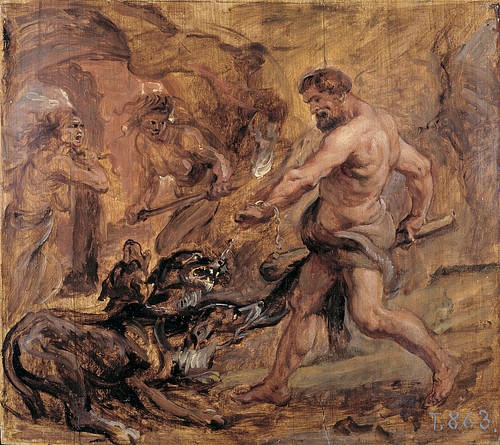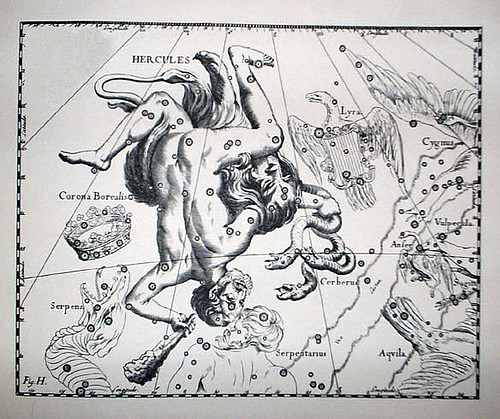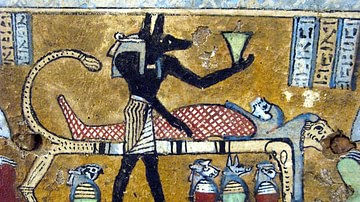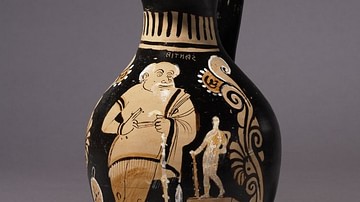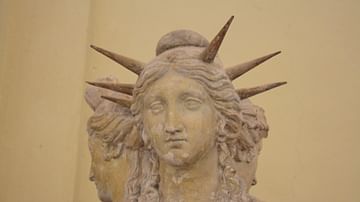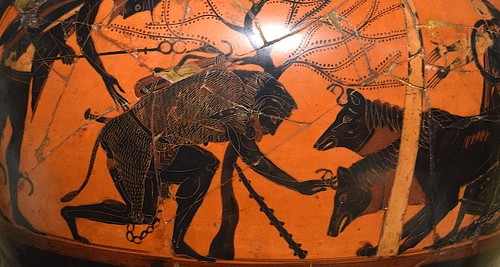
Cerberus (also spelt Kerberos) is a vicious three-headed dog in Greek mythology, who guards the entrance to the underworld. He allowed the souls of the dead to enter Hades but prevented the living (except for a few exceptions) from entering. Cerberus is a son of Typhon, a Giant, and Echidna, a half-woman, half-snake creature.
Anubis is the Egyptian counterpart of Cerberus. Like Cerberus, he had the head of a dog and guarded the underworld. Cerberus' name is first mentioned in Hesiod's (c. 700 BCE) Theogony.
Birth & Family
In his Theogony, Hesiod states that Cerberus was the son of Typhon, a serpentine Giant that breathed fire, and Echidna, a half-woman and half-snake creature. In addition, he was the brother of other fearsome creatures, including the two-headed dog Orthos and the Lernaean Hydra (a water serpent).
They say that Typho, terrible and proud
And lawless, loved this nymph with glancing eyes,
And she conceived and bore fierce progeny:
First, Orthos the dog of Geryon, and next,
Unspeakable Cerberus, who eats raw flesh,
The bronze-voiced hound of Hades, shameless, strong,
With fifty heads.(Hesiod, Theogony, 310-316).
The Hound of Hades
As a faithful companion to Hades, king of the underworld and god of the dead, Cerberus was known as the 'Hound of Hades' – a title first used by Homer (c. 750 BCE). He was also called a 'Hell Hound'. Hecataeus of Miletus (c. 550 to c. 476 BCE) believed Cerberus was called the Hound of Hades because a deadly serpent was bred at Tainaron (Cape Matapan). Anyone who was bitten by it died immediately from the poison.
Ancient beliefs regarding the afterlife did not do much to comfort humankind. Idyllic places like The Isles of the Blessed and the Elysian Fields (Elysium) were reserved for immortals and heroes, while Hades and Tartarus were seen as dark, foreboding places with monsters like Cerberus guarding them. Cerberus guarded the underworld, allowing those who had already crossed the River Styx to enter but preventing the living from setting foot in the underworld by devouring them. If a soul tried to escape from the underworld, Cerberus would catch them.
Cerberus was described as having three heads, each with snarling, sharp fangs, and serpent heads for tails as well as snake heads on his back. Although most sources state that Cerberus had three heads, Hesiod mentions that Cerberus had 50.
Theseus & Pirithous
King Pirithous of the Lapiths invited his friend Theseus to visit Sparta with him so that they could attempt to marry Helen, sister of the Dioscuri. They both swore an oath to each other – to draw lots for Helen's hand in marriage, with the loser getting to marry another one of Zeus' daughters.
They rode into Sparta with an army and ambushed Helen while she was at a temple. After drawing lots, Theseus was the winner. However, Helen was still a child, and Theseus did not wish to cause any problems with the Dioscuri, so he sent Helen to another village to be guarded by his friend, Aphidnus, and to be cared for by his mother. Once Helen was older, Pirithous reminded Theseus of their pact, and they consulted an oracle of Zeus. This oracle suggested that they seek Persephone as a bride for Pirithous. Although Theseus wanted no part in this plan, he remained true to his oath and accompanied Pirithous down to Hades. They knocked at the gates of Hades' palace and asked for Persephone.
Hades listened calmly to their request and invited them to sit down. Unbeknownst to Theseus and Pirithous, Hades had instructed them to sit in the Chair of Forgetfulness. They became trapped as Cerberus and the Furies attacked them, and Hades looked on. When Hercules entered Hades to capture Cerberus, he was able to rescue Theseus but was prevented from saving Pirithous.
The Twelfth Labour of Hercules
The most well-known myth involving Cerberus is the tale of the Twelve Labours of Hercules. King Eurystheus of Tiryns had set twelve labours for the legendary Greek hero after he had gone mad and killed his children. These challenging and dangerous tasks were a way for Hercules to atone for his actions.
The twelfth and last labour was the most dangerous one yet. Hercules had to bring Cerberus up from Tartarus. Before descending into the underworld, Hercules had to be cleansed for his murder of the centaurs and inducted into the Greater Mysteries (Eleusinian Mysteries), with Theseus as his sponsor. Hercules entered the Underworld from near the Black Sea, with Athena and Hermes guiding him. Charon, the boatman of Hades, did not hesitate to ferry Hercules across the rivers of the underworld.
As Hercules stepped out of the boat, all the souls of the dead fled, except for the Gorgon Medusa and the Greek hero Meleager. Hercules armed himself but was reassured that ghosts could not harm him. After freeing his friend Theseus, Hercules demanded that Hades and Persephone hand over Cerberus. Hades replied that Hercules could have him if he could overpower him without using any weapons. Hercules found Cerberus chained to the gates of Acheron and grabbed him by the throat. Cerberus raised his three heads and his barbed tail as a warning, but Hercules was protected by his lion pelt and continued to apply pressure to Cerberus' throat until he weakened and yielded.
Son of Zeus that I was, my torments never ended,
forced to slave for a man not half the man I was:
he saddled me with the worst heartbreaking labours.
Why, he sent me down here once, to retrieve the hound
that guards the dead - no harder task for me, he thought-
but I dragged the great beast up from the underworld to earth
and Hermes and gleaming-eyed Athena blazed the way!(Homer, Odyssey, 11. 711-717).
Athena helped Hercules cross the River Styx while he half-carried a chained Cerberus. In some retellings of the tale, including Pausanias' (c. 115 to c. 180 CE) Description of Greece, Hercules brought Cerberus up through a chasm near Troezen (in the Peloponnese), while others say that he took him to the Acone Cave near the Black Sea.
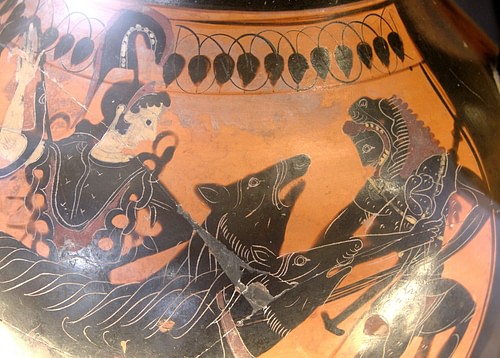
As Cerberus barked with all three heads and struggled against Hercules, his saliva landed on the ground and caused the poisonous aconite plant to grow. Hercules took Cerberus to King Eurystheus in Mycenae, where the king offered a sacrifice. Instead of providing Hercules with a sizeable share of the sacrifice, he gave him a small portion and saved the best for his family. Hercules was rightly offended by this and killed Eurystheus' sons. After presenting Cerberus to King Eurystheus, Hercules returned him to Hades. Hercules was the only Greek hero to defeat Cerberus physically.
Tricking Cerberus
Cerberus was sometimes tricked, which allowed the living to sneak past him into Hades. The nymph Psyche used honey cakes to placate the vicious dog so she could collect a box from Persephone – a task that was necessary to rescue her lover Eros. In Greco-Roman mythology, the prophetess Sybil used honey cakes that had been dipped in drugged wine to put Cerberus to sleep so the Greco-Roman hero, Aeneas, could enter Hades to speak to his father Anchises.
A venomous snake bit the nymph Eurydice as she fled the advances of the beekeeper Aristaeus. After she had died, her husband, the famed poet Orpheus, descended into the underworld, intent on getting her back. Once he had arrived in Hades, he used his lyre to bewitch Charon, Cerberus, and the three Judges of the Dead (Rhadamanthys, Minos, and Aeacus).
Thanks to his lyre, Orpheus was able to persuade Hades to let Eurydice go on one condition, that he did not look back until he was safely back above ground – a challenge that he sadly failed.
In another source, Cerberus refused to let Orpheus pass, so Orpheus wandered the world in grief, playing his lyre.
Cerberus' Poison
After Medea had fled from Corinth and taken refuge with King Aegeus of Athens, she gave birth to Aegeus' son, who she believed would one day inherit the throne from his father. However, Theseus, Aegeus' secret son, showed up in Athens. Medea was wary of this new threat to her son and persuaded Aegeus that Theseus was a spy. They invited Theseus to a feast where Aegeus offered him a goblet of wine.
Unbeknownst to him, this wine was poisoned with wolfsbane, which had sprung into existence from Cerberus' deadly saliva that was scattered over the earth after Hercules had dragged him out of Hades.
Art
One of the most famous depictions of Cerberus in Greek art can be found on the Perseus Vase, which is currently on display in the Louvre Museum. It shows Hercules holding Cerberus on a red leash. In Pausanias' Description of Greece, he mentions that in Laconia, there was a statue of Apollo, and on the right of the statue were two sculptures depicting some of Hercules' labours – the capture of Cerberus and his removal from Hades and the killing of the Hydra. At Olympia, near the River Erymanthos, Hercules' labours were recorded and offerings were made to honour the great Greek hero.
Legacy
The now-obsolete Cerberus constellation was discovered and named in 1690 by the Polish astronomer Johannes Hevelius (1611-1687). It depicted a three-headed serpent rather than a dog, and it is now a part of the Hercules constellation.
The French naturalist Georges Cuvier (1769-1832) named a genus of Asian snakes Cerberus in 1829. Commonly known as the dog-faced water snake (Cerberus schneiderii), it is found across Asia and in Australia. There are currently five different species that can be found in the wild.

